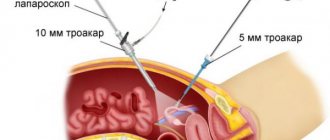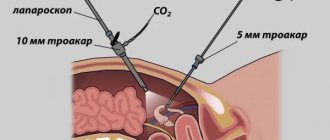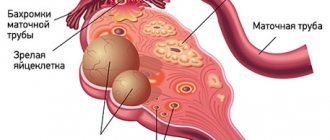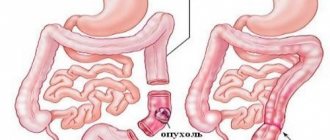Why might my right side hurt?
The causes of this symptom are usually associated with internal organs. “This is a sign that something located on the right side of the abdomen is suffering,” says Bulat Yunusov, a surgeon at GMS Clinics and Hospitals. “The cause of damage to these organs can also be different, for example, inflammation, oncological processes, trauma, consequences of previous operations, neurological disorders.”
However, this symptom may have other reasons. “An unpleasant sensation in the right side can be muscular in nature, especially if it occurs after physical activity. If a person falls on their right side, the pain may be associated with muscle contusion or injury, such as myositis. Gallstones can also cause an uncomfortable tingling sensation in your side. The stones close the ducts, which leads to swelling of the bladder and, as a consequence, to the occurrence of calculous cholecystitis, that is, an inflammatory process. All this, of course, is accompanied by pain,” commented an invited specialist from another medical center. Let's look at the main causes of pain in the right side.
Important to remember
- Laparoscopy is not only surgery, but also expanding diagnostic capabilities
- When choosing a surgical treatment method, you need to focus on the characteristics of the patient and the skills of the operating doctor.
- Robotic stands and other laparoscopic techniques help the patient when the operation is performed by experienced surgeons
- The development of new surgical techniques makes it possible to perform increasingly complex operations and improves the prognosis for recovery and return to normal life.
Inflammatory diseases of the gastrointestinal tract
Pain and cramps in the right side can be caused by a whole “bouquet” of inflammatory processes in the gastrointestinal tract. “These are, for example, appendicitis, diverticulitis, colitis, gastroenteritis, stomach and duodenal ulcers,” says Bulat Yunusov.
Most often, with these diagnoses, the pain is felt as aching, moderate, with gradually increasing intensity. With appendicitis, pain may increase when walking, coughing, changing body position and decrease at rest. Also with this diagnosis, there is an increase in temperature, nausea, and vomiting.
With a stomach ulcer, the pain becomes more noticeable after eating fatty, spicy or fried foods, alcohol, and intense physical activity. Additional symptoms may include heartburn, nausea, and vomiting.
With colitis (inflammation of the intestines), the pain can be nagging or paroxysmal. The disease is also accompanied by diarrhea, fever, general weakness, headaches, and the presence of mucus in the stool.
With diverticulitis (protrusion of the intestinal walls), acute pain is felt to the right of the navel, the temperature rises, and diarrhea (with blood and mucus) appears.
With gastroenteritis (inflammation of the mucous membrane of the stomach and small intestine), pain in the right side is accompanied by lack of appetite, nausea, vomiting, abdominal cramps, etc.
With pancreatitis (inflammation of the pancreas), the pain begins suddenly and is constant and intense. Sometimes it can “give” to the left side or get worse after eating heavy, fatty or spicy foods.
What it is
Laparoscopy is an operation or examination of internal organs using small incisions. First, through one incision, a special instrument is introduced into the body - a laparoscope, to which a camera and a lighting device are attached. If the study is carried out in the abdominal cavity, it is inflated with carbon dioxide. This allows the surgeon to see the internal organs better and gives space to work.
The image from the camera is displayed on the monitor: this is how the doctor sees what is happening in the cavity. After the examination is completed, carbon dioxide is removed from the abdominal cavity, then the surgeon removes the laparoscope, sutures the incisions and applies a bandage.
If surgery is necessary, instruments are inserted through additional incisions. With their help, you can remove tissue, ligate a vessel, or take part of an organ for examination. Other, more complex manipulations are possible, but this depends on the quality of the technique and the skill of the surgeon.
With the help of laparoscopy, you can not only remove the appendix, gallbladder, kidney stones or other formations, but also carry out diagnostics in doubtful cases. For example, if acute appendicitis is suspected, it is sometimes better to make a one-centimeter incision and look at the abdominal cavity from the inside. This can confirm the original diagnosis or make sure that the patient’s condition is caused by other reasons.
Laparoscopic technology has expanded treatment and diagnostic options. Using a bronchoscope, you can take tissue for analysis and determine the causative agent of the infection or remove pieces of food from the bronchi if the patient accidentally inhaled them.
Before the advent of laparoscopy, this was a life-threatening complication. This situation could lead to the development of infectious complications and death of the patient. They tried to remove the foreign body of the bronchi by washing through a breathing tube or by open surgery on the chest, but this did not always lead to a good result.
An endoscope helps to determine the condition of the esophagus, stomach and upper intestine. You can clarify the diagnosis of gastrointestinal disease, remove a foreign body or polyp through natural openings.
With an arthroscope, you can look at large joints from the inside through a small incision to determine the cause of the disease and then operate. This way you can remove damaged tissue, reduce swelling or repair damaged ligaments without additional interventions.
“Operations have become more technologically advanced, more predictable and orderly,” says Sergei Stoilov, candidate of medical sciences, surgeon, urologist at the Semeynaya clinic, “and laparoscopic technology has been added to modern examination methods. At first, the doctor only had an examination and the patient’s complaints, then ultrasound was added, which expanded the horizons of diagnosis. Now there are CT and MRI. Techniques for surgical simulation and three-dimensional reconstructions have appeared. Now the doctor knows exactly where the vessels are and how to approach them - this simplifies the surgical technique and improves prognoses.”
Laparoscopic techniques, combined with other modern treatment methods, have changed the approach to routine surgeries and reduced the stress of surgical treatment. For example, removal of the gallbladder used to result in an abdominal incision of up to 18–20 cm, a long recovery time, and a high risk of adhesions. With laparoscopic surgery, it is enough to make three to five small holes, which will heal quickly.
Before the development of laparoscopy, a stone in the genitourinary system could bring inconvenience, pain and greatly reduce the patient’s quality of life for years. Especially if it was not possible to crush the stone using ultrasound. If complications developed, such as urinary tract blockage, surgeons sometimes had to remove the kidney.
“The presence in the surgeon’s arsenal of modern electrosurgical devices: laser, ultrasound have changed the approach to some operations,” says GMS Clinic surgeon Bulat Yunusov, “for example, you can crush and remove a kidney stone without making a large incision, as before. With the development of laparoscopic techniques, the technique of performing the operation has changed.”
Diseases of the urinary system
Often the side on the right side hurts due to the organs of the excretory system. “These include urolithiasis and pyelonephritis,” says Bulat Yunusov.
Pyelonephritis is an inflammatory disease of the kidneys, in which, in addition to pain in the right side, weakness, nausea, vomiting, “jumping” pulse, dry mouth, and high temperature may also occur.
Pain in the side due to urolithiasis can be constant or wave-like, dull or sharp, it can only bother you at rest or intensifies when walking. It depends on the location of the stone, but sometimes the pain may first be felt in the lumbar region (so-called “renal colic”), and only then “settle” in the right side.
When not to
Laparoscopic operations are not performed if:
- shock states, when there is no time to prepare equipment and the patient;
- bleeding disorders, due to a high risk of bleeding;
- hernia of the anterior abdominal wall or diaphragm, increased pressure in the abdominal cavity can lead to complications of the condition;
There are conditions in which the doctor can weigh the risks and choose the classic approach:
- adhesions in the abdominal cavity or pelvis after previous operations;
- obesity. At the same time, the doctor may have difficulties due to the limited available space for instruments;
- serious chronic diseases: cardiovascular, asthma.
In addition, surgeons must constantly train and practice to become proficient in this manipulation. If the hospital does not have the capabilities for this, then the doctor can choose a classic open approach to reduce risks.
“The high cost of training specialists,” says Sergei Stoilov, “and the need to keep them in “working shape,” can be attributed to the disadvantages of laparoscopy. Practice on dummies or laboratory animals is required. Then a more experienced surgeon is needed to supervise the operation. He will prevent mistakes, advise and help so as not to risk the health of patients.”
Liver diseases
“Pain in the right side can occur with damage to the liver and organs of the hepatobiliary system,” notes Bulat Yunusov. “Such diseases include cholecystitis, obstructive jaundice, liver cysts, hepatitis, and cirrhosis.” All of these diagnoses are characterized by fairly sharp pain in the right side, which can “radiate” to the right shoulder, neck or shoulder blade.
Women often experience pain on the lower right side due to malfunctions of the pelvic organs. “Such work disorders include inflammatory diseases (salpingitis, salpingoophoritis) and non-inflammatory (corpus luteum cyst, ovarian tumors, endometriosis, ovarian cysts, ectopic pregnancy),” notes Bulat Yunusov.
With salpingitis (inflammation of the fallopian tubes) and salpingo-oophoritis (inflammation of the fallopian tubes and ovaries), the pain is most often felt as a pulling in the groin area, but it can also “radiate” to the right or left side. Accompanied by fever, nausea, severe headache, vaginal discharge and intensifies during sexual intercourse.
With ovarian or corpus luteum cysts, pulling or stabbing pain is mainly localized in the lower abdomen or lower back, but can also be felt in the right side.
With endometriosis, the pain is most often acute, cramping, and can disappear and return. It is felt, as a rule, in the lower abdomen, in the left or right side (closer to the lower back).
Response to physical activity
Sometimes the right side hurts not due to malfunctions in the internal organs (which we discussed above). If you feel pain on the right side during (or immediately after) physical activity, there is a chance that it is:
- Muscle spasm caused by weakness in the muscles of the back or abdomen.
- Diaphragm spasm. It is most often encountered while running: rapid breathing causes the diaphragm to contract faster, which can cause it to spasm and “give off” pain in the right side.
- Increased liver function. This organ is considered the “blood” depot of the body. During training, the liver may increase slightly in volume and “press” on its outer capsule, where there are many nerve endings, which will be felt as pain in the right side. And such discomfort can also arise due to an incorrect diet: for example, if before training you “got too much” with carbohydrates or fats. In this case, during exercise the liver will be forced to work under increased load, which can also provoke pain.
How to determine why you have pain in your right side
Of course, you won’t be able to make an accurate diagnosis on your own. However, you can get some idea about it based on exactly how your right side hurts. “In acute diseases, pain occurs suddenly, increasing in intensity in a short period of time (hours, sometimes days),” notes Bulat Yunusov. “If the cause is some kind of chronic disease, then the pain syndrome is either constant or wave-like in nature, not very intense.”
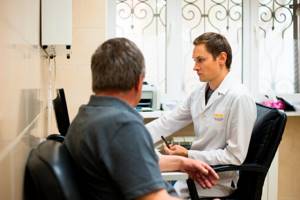
It is also important to check for additional symptoms. “To correctly determine the cause of pain in the right side, you need to listen to the nature of this pain. For example, muscle pain is usually dull and aching,” the invited specialist commented. “However, muscle pain can also be acute, since in addition to the muscles in the right side there are intervertebral joints that can be a source of discomfort. In case of cholelithiasis or acute cholecystitis, the pain is accompanied by fever. This situation can be called “pain-plus” - pain and fever. Discomfort caused by renal colic can also be “pain-plus,” but pain plus frequent urination or the presence of blood in the urine. Pain caused by intestinal problems—pain plus diarrhea.”



